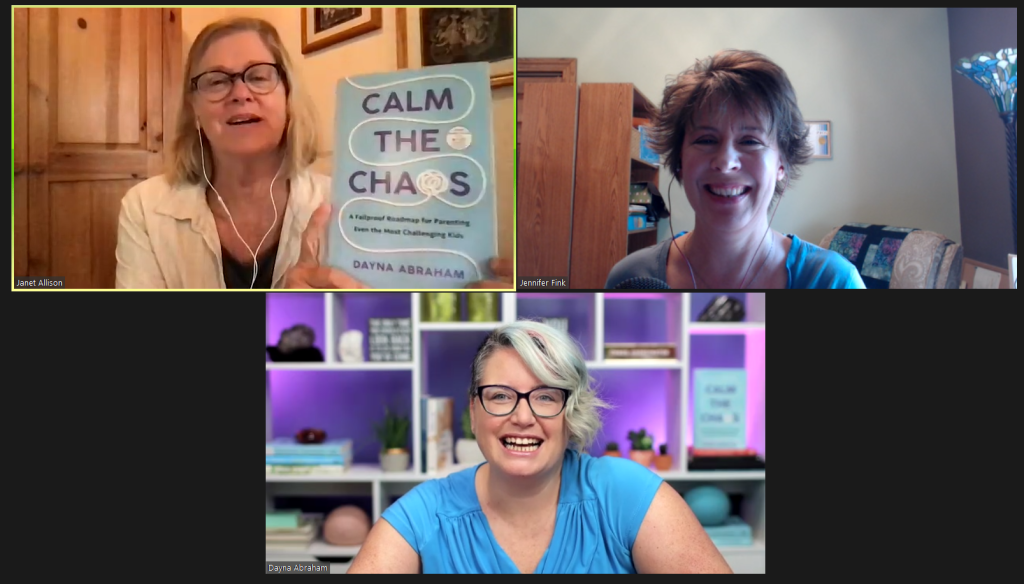color: #ea404d;
text-decoration: none;
}
.redcircle-link:hover {
color: #ea404d;
}
.redcircle-link:active {
color: #ea404d;
}
.redcircle-link:visited {
color: #ea404d;
}
Powered by RedCircle
How do you calm the chaos in your household?
Big emotions, power struggles, and challenging behaviors can create (& feed!) chaos, affecting the entire family. And it’s next to impossible for anyone to operate at their best in a constant state of chaos.
“I felt like an absolute failure for the first seven years” of parenting, says Dayna Abraham, author of Calm the Chaos: A Fail-Proof Roadmap for Parenting Even the Most Challenging Kids. “The calls from school were coming daily. My son was kicked out of school more days than he was in school.”
Roadmap to Calm
There are 5 steps (or stages) on the roadmap to calm, Dayna says:
- Ride the storm. In this stage, you hunker down instead of trying to fix or solve. “Instead of ‘doing,’ you are literally just getting to safety.” she says. (Note: What is a Category 3 storm for you may be a Category 1 storm for someone else, and that’s okay. Ride out the storm!)
- Time & energy reserves. Most people want to skip this stage and move straight to problem-solving. But if you don’t refill your energy reserves, you will not have the energy or stamina required to move forward. This stage is about building small habits that boost your energy – & removing things that drain you.
- The moment. This is when you start thinking about how you’re going to respond when certain behaviors or situations arise. It’s when you figure out, “How do I show up that diffuses that situation faster and minimizes damage?” Dayna says. “How do I stay connected & curious in the moment?” Resist the urge to catastrophize.
- Stop storm chasing. Now, you can get ahead of the “chaos causer” — the topic or issue that’s triggering a lot of stress and chaos. Focus on ONE THING, and work collaboratively with your child to address it.
- Teamwork. Get the whole family together to create an “ecosystem” that supports calm. Discuss each of your unique needs and figure out how you can support one another. During this stage, kids learn how to pay attention to each other’s needs, struggles, likes, and dislikes. “When you can understand and predict each other’s ups and downs, things get a lot easier,” Dayna says.
Unfortunately, “a lot of the advice out there starts at what I call Stage 4 or Stage 5,” Dayna says. What happens when you jump to problem-solving — & skip the first three stages — is that you and your kids aren’t ready for change & you all quickly become overwhelmed.
In this episode, Jen, Janet, & Dayna discuss:
- Unhelpful online parenting advice
- Parenting challenging boys
- How catastrophizing affects our parenting
- Managing our body language and tone of voice
- Why you should greet your son like a puppy
- The 1-1-1 strategy that can help you respond in the heat of the moment
Links we mentioned (or should have) in this episode:
Calm the Chaos: A Fail-Proof Roadmap for Parenting Even the Most Challenging Kids, by Daya Abraham
calmthechaosbook.com — includes links to Dayna’s bonus material
lemonlimeadventures.com — Dayna’s website
Constant Chaos Parenting w ADHD — ON BOYS episode
How to Be an Unflustered Mom — ON BOYS episode
Sponsor Spotlight: Better Help
Therapy to help you live a more empowered life. Go to BetterHelp.com/onboys to save 10%
Sponsor Spotlight: Essential Labs
Use code ONBOYS to save 15%
Sponsor Spotlight: Factor
Use code ONBOYS50 for 50% off
Sponsor Spotlight: Smart for Life
Use code ONBOYS20 for 20% off your next order




